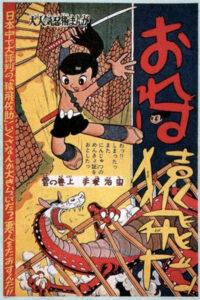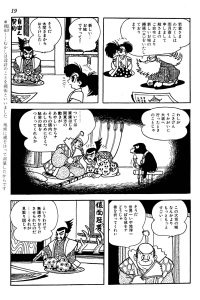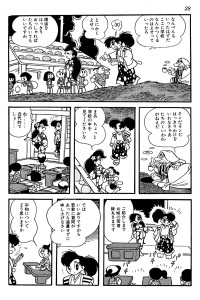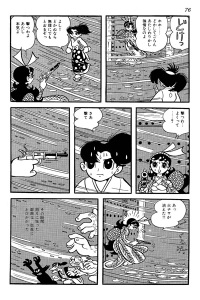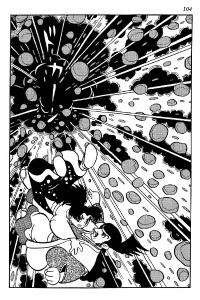I am Sarutobi! (Manga)
Also known as おれは猿飛だ! (Oreha Sarutobida!)
| English Title: | I am Sarutobi! |
| In English? | No |
| Japanese Title: | おれは猿飛だ! [Oreha Sarutobida!] |
| Type: | Ongoing Serial |
| Original run: | 1960/01 – 1961/02 |
| Published in: | Manga King [漫画王] |
| Published by: | Akita Shoten |
| Volumes: | 2 (MT-215 | MT-216 ) |
Originally published from January 1960 to February 1961 in Manga King, Osamu Tezuka’s I Am Sarutobi! (1960-61) is another of Tezuka’s samurai-style series, including Castle of Dawn (1959-61) and The Shinsengumi (1963), which draw on well-known characters and events from Japan’s feudal history.
What it’s about
Set in 18th year of the Tensho period (i.e. 1590), a young ninja name Sasuke Sarutobi encounters an army of Samurai on the march. Using his magic tricks, he handles them easily, but when his magic suddenly fails him, it’s up to his friend, and fellow ninja Sai to save. Sasuke then discovers that Master Tozawa has removed his powers until he’s worthy of them. This has dire consequences when the army descends on this village and kills Sasuke and Sai’s family and he’s powerless to stop them.
An itinerant monk named Seikai Miyoshi recruits the vengeful Sasuke into a clandestine group of men looking for revenge. When Master Tozawa hears of this he summons Sasuke and explains that he revoked his ninja magic because it should only be used in defence, never to harm others. He then reinstates Sasuke’s magic and warns him not to end up like his former pupil, the brigand Goemon Ishikawa, and then sends him to the capital in Kyoto to investigate the situation.
Although extremely direct and confident in his own abilities, Daisuke shows his lighter side through his immense appetite for shiruku
The life and the hierarchy within the group are immediately established and explained but the story moves elsewhere because it is always well a story of revenge.However, it is the group membership to drag our protagonist in larger intrigues him and make him, in turn, the subject of a vendetta. Here, as in Kaze Hikaru , Serizawa Kamo is represented as angry, drunk and cause trouble (shows the famous incident with the sumo wrestler, the restaurant and Silk shop) what is fictional is its ending. Despite everything, saw the presence of historical characters and events that occurred, the romance and history intertwine quite well.
were a time of political upheaval in Japan, with the grip of the Shogunate loosening and reformists seeking to open trade with the West.
Although Kyujuro Fukakusa joins the Shinsengumi in the hopes of finding his father’s killer and having his revenge, he slowly becomes disillusioned with the group. Of course, switching sides is never easy, and Kyujuro eventually ends up facing off against his close friend, Daisuke Kamakiri… under a sky full of beautiful fireworks.
The protagonists in Tezuka’s Shinsengumi weren’t the famous members of the nineteenth-century band of warriors that went by that name, like Hijikata Toshizō or Okita Sōji.
It wasn’t possible to alter the main tale of what happened to the Shinsengumi, so he shifted the focus of his work by bringing minor characters to the fore. All these little touches were fodder for my study as well. I’m also a fan of Tezuka’s Hidamari no ki [Sunlit Tree, published by Shōgakukan]. It’s set after the 1867 end of the Tokugawa shōgunate, in the rapidly changing city of Tokyo, and it’s populated with people whose vistas have suddenly opened wide, people with no problem keeping up with the pace of change, and people clinging to the world of the past. I think this is a marvelous portrayal of all these people living through an era of upheaval. It was such a complex time in history. How, I wondered, could Tezuka put it on paper in such an easy-to-understand way?
In 1594, during the Momoyama Period, Japan was ruled by Lord Hideyoshi Toyotomi. However, in an effort to blunt the movements of his main rival, Lord Ieyasu Tokugawa, in the Kanto region (now home to modern-day Tokyo) to the north, Lord Toyotomi instructs his vassal, Lord Muneharu Matsunoki to construct a new castle on his lands. This is not to be just any castle though… but one built in a traditional European style – a plan so secret, that even a suspected glimpse of the blueprints could mean the death penalty. Lord Matsunoki whole-heartedly embraces the task ahead of him, and decides to bring his son, the young Lord Midorimaru Matsunoki, on board to help him.
A brash and fearless youth, at first Midorimaru is excited by the project. However he quickly realizes that the site selected for the new castle is already occupied, and that its construction will mean the destruction and relocation of a peasant village – including a school for young children. Although Midorimaru encourages the school’s young and beautiful teacher, O-Tae to leave, given the secrecy of the project, he is unable to provide her with a compelling reason to do so. Eventually O-Tae’s stubborn refusal lands her in prison.
Haunted by thoughts of O-Tae’s anti-war stance, Midorimaru begins visiting her in the dungeon and eventually comes to see the error of his ways – and specifically his father’s plans. When news of these visits reach the Lady Yayoi, the most beautiful girl in the castle and all-but-betrothed to Midorimaru, it throws her into a jealous rage and she is soon plotting to have O-Tae put to death for her “crimes”. When Midorimaru catches wind of the plot, he saves O-Tae and renounces his noble status, preferring to live a simple peasant life with her rather than be associated with the new castle project.
Meanwhile, as construction begins on what will become known as the “Castle of Dawn”, the project is almost halted before it begins as a series of fatal accidents ybegin to look more and more like acts of sabotage. Despite potentially having a traitor in his midst and a mounting casualty count, including Minister Yabuhebi, the Chief Retainer and Yayoi’s father, for Lord Matsunoki, completing the castle, at any or all cost, has become a single-minded obsession.
Of course, her father’s death and suspected murder puts Yayoi down a path looking for revenge, and Midorimaru, despite living the quiet life of a peasant, is drawn into the search for the traitor and saboteur. However, when Lord Hideyoshi dies, and Tokugawa troops take the field, the future of Lord Matsunoki’s life’s work – one which he has sacrificed everything for – becomes less and less certain…
What you should know
Brave and determined heroes to some, ruthless murder squads to others, it is against this backdrop of moral ambiguity that Tezuka sets his samurai tale, Shinsengumi (1963).
Like many of Tezuka’s manga, Castle of Dawn (1959-61) features a very strong anti-war message. However, instead of merely preaching to his readership, Tezuka cleverly crafts his message to be delivered “from the mouths of babes” by having his dashing young hero, Midorimaru, have to defend his violent samurai lifestyle against an onslaught of wholly-reasonable questions posed by schoolchildren. Why, for example, couldn’t Lord Toyotomi and Lord Ieyasu Tokugawa just hold a joint summit and sit down and talk out their differences? Furthermore, by following this up with his hero effectively renouncing his life of violence by opposing his father’s plans, Tezuka makes his point quite clearly.
However, despite making his point, Tezuka is also well-known for pushing his readers, even the young ones, to question the motivations and ethics of his characters, and letting them form their own thoughts and opinions. Castle of Dawn (1959-61) is no exception. By introducing a charismatic traitor into the mix, Tezuka is able to show that sometimes good men do bad things, for good reasons… Often to tragic outcomes. He also shows that there are consequences to folly, and not all stories have happy endings.
Finally, Tezuka never lets an opportunity slip by for an inside joke or two. One prime example of this is the depiction of the monkey eating ice cream in Lord Hideyoshi Toyotomi’s chambers… A fun little poke at Hideyoshi’s nickname of Saru (Monkey) due to his less-than-handsome features. Another is the name of the Tokugawa general that comes to lay siege to the Castle of Dawn, Mitsutoshi Furuya… a mangaka who was one of Tezauka’s assistants at the time.

